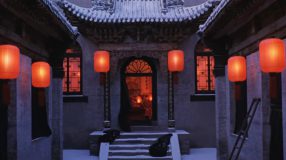RAISE THE RED LANTERN, DIR. ZHANG YIMOU (1991)
Qiao Family Courtyard, Jinzhong, Shanxi
The movie I chose is Raise the Red Lantern directed by Zhang Yimou, which was thoroughly filming in the famous Courtyard of Qiao’s family. The movie revolves around the topic of feudal ethics where the story begins from the female college student Song Lian who was forced to marry the master of a big family by her greedy mother, the story tells about the conflicts between the concubines and a series of tragedies in a large family during the Republic of China era.
The overall performance of the building and the interior scenery in the lens were rich in details. In the movie, there were many top-down shots of the Qiao’s courtyard which was surrounded by high walls, creating a sense of depression. The people inside, especially the women who were mutilated under the feudal ethics, had been imprisoned there throughout their lifespan. In addition, the spacious interior setting forms a sharp contrast with the small characters, which further highlights the depression. The houses in the film were covered by cyan grey as the main color tone, giving the viewers a gloomy and lifeless feeling. Also, there were lots of perspective shots through the doors and windows of the corridor. According to a piece of interview from Director Zhang, this kind of square perspective line was aiming at expressing the central idea of big family: “没有规矩,不成方圆 (“square” represents standard and norms in Chinese meaning)”, to express the shackles and repression ¹.

Fig 1. Top-down perspective,the whole courtyard looks like “cage”, or even “coffin”. Source: YouTube

Fig 2. Spacious room and tiny characters. Source: YouTubeFig 3. Square perspective lens, emphasizing “cage” and “rules”. Source: YouTube

Fig 3. Square perspective lens, emphasizing “cage” and “rules”. Source: YouTube
While the Qiao’s Courtyard in reality, used to be belonged to the mansion of Qiao Zhiyong who was a famous commercial capitalist in Qing Dynasty. The layout is in the shape of “喜” (Chinese for auspiciousness), and the orientation of the courtyard is arranged in strict accordance with geomancy. Different from the gloomy and weird tone in the film, the courtyard is in a grand and majestic style in reality, and it is obvious to see the prosperity of the Qiao’s family ².

Fig 4. In reality, after renovation, more exquisite, give a sense of abundance. Source: Photo. Pconline
On the basis of the gloomy color tone, the use of the red lantern, a key prop, was not only to promote the plot development of the film and echoing with the “rules”, but also as the main technique of the director to contrast with the gloomy tone. In traditional Chinese culture, the “red “ symbolizes happiness and warmth, but in this movie, it is used as a foil to sadness. In my opinion, this kind of red in the gray symbolizes a kind of resistance from women under the oppression of feudal ethics, a kind of indomitable living for themselves. At the end of the film, when the lantern at the gate of the heroine Song Lian was sealed with black cloth, it symbolizes the failure of her resistance. The feudal cage was so indestructible, just like the courtyard surrounded by the thick high walls, which was extremely ironic

Fig 5. Even if hunging with red lanterns, there was no warmth, but even more gloomy. Source: YouTube
— Yulan Shen, 3035603942
References:
¹ Yan, Ting 闫婷. “Zhang Yimou Pingyao Tu Zhenyan 张艺谋平遥吐真言 [The truth telling of Yimou Zhang]” Shanxi News, Sohou, (2019). https://www.sohu.com/a/346484292_115635.
² Yao, Lu 姚璐. “Qiaojia Dayuan Jianzhu zhi Mei 乔家大院建筑之美 [The Architectural beauty of Qiao’s courtyard]” WENYI SHENGHUO, no.4 (2017). https://wenku.baidu.com/view/3ecea466a9114431b90d6c85ec3a87c241288a6f.html?fr=income2-wk_app_search_ctr-search.
Movie Clip Source: Youtube, 《大红灯笼高高挂》https://www.youtube.com/watch?v=uxnyXIpiFmM.
Picture Source: 太平洋摄影博客, 乔家大院 https://dp.pconline.com.cn/dphoto/list_3681581.html
I appreciate your thorough comparative analysis, especially in terms of lighting and color. Also, you noticed that the red lantern, as a symbolic prop, plays a significant role in promoting plot development and metaphorically represents women’s resistance to feudal ethics. Furthermore, it is powerful fieldwork getting references from interviews, papers, and film reviews, even though it is conducted virtually. Nevertheless, I would suggest you select the photographs shot from similar perspectives as the film scenes to achieve a stronger comparative effect. And associating your report with the ideas/theories/concepts of coursework might make your report more critical and reflective.